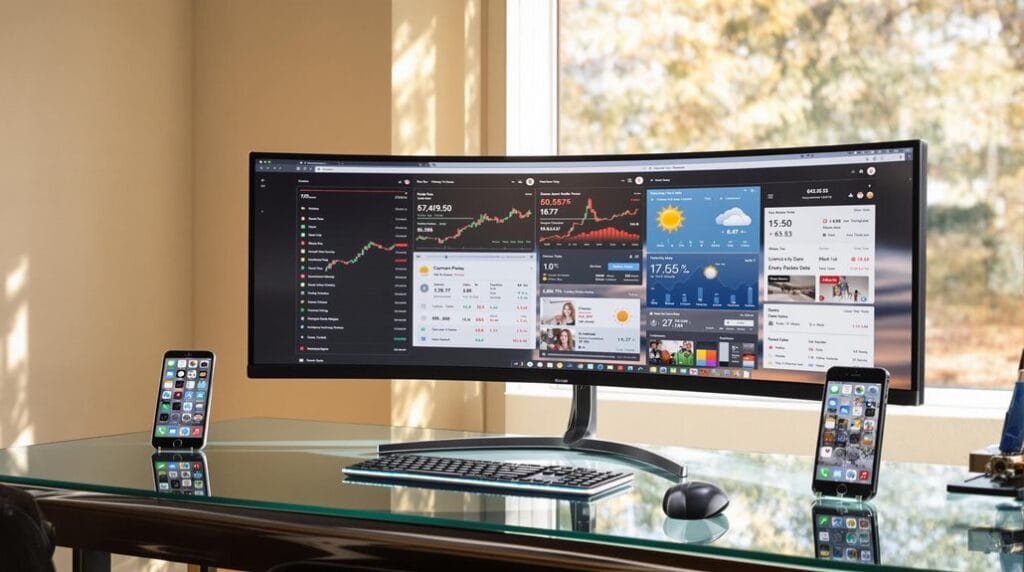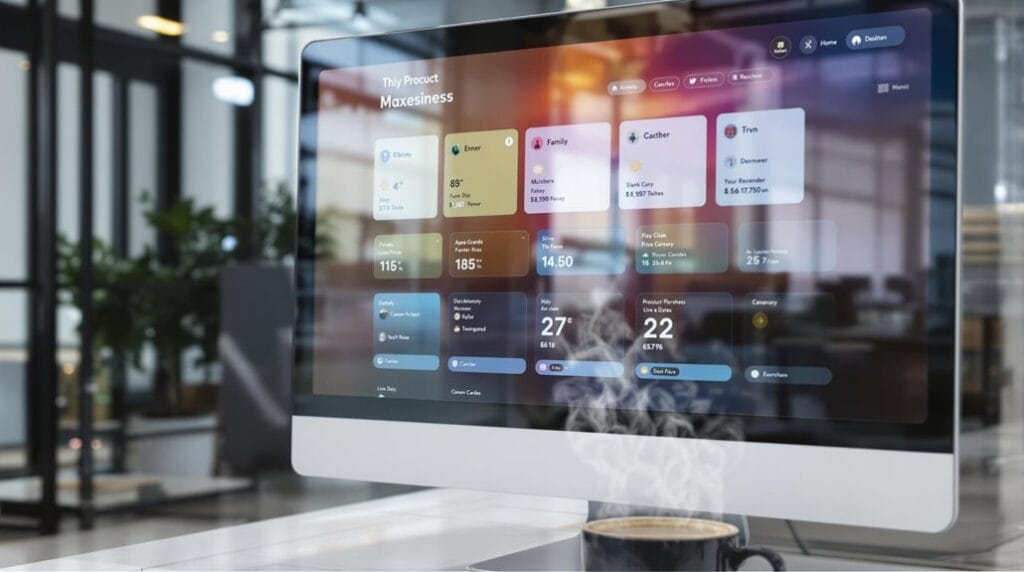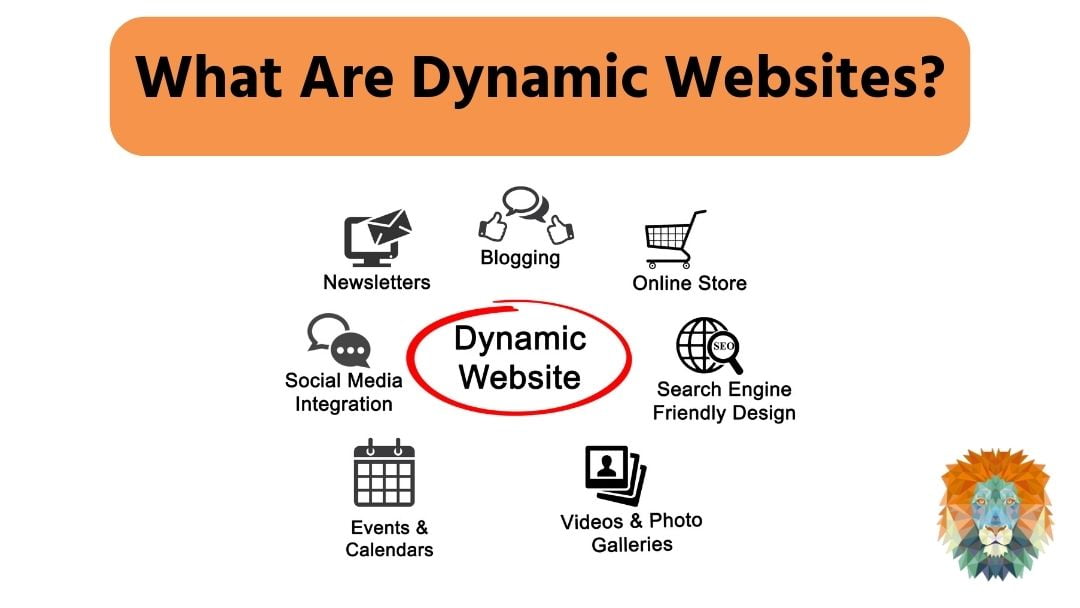When you’re browsing modern websites, you’ll notice that many of them seem to know who you are, remember your preferences, and update their content without reloading the page. These aren’t static web pages but dynamic websites that adapt and respond to your actions in real-time.
Unlike their static counterparts, dynamic sites leverage powerful server-side technologies and databases to create personalised experiences tailored to each visitor. While you might take these interactive features for granted today, the technology behind them represents a sophisticated blend of programming, design, and user experience principles that’s worth understanding more deeply.
Key Takeaways
- Dynamic websites generate content in real-time and adapt to user interactions, displaying different content based on visitor preferences and behaviour.
- They use server-side scripting languages like PHP and Python to process requests and interact with databases for content delivery.
- Content updates automatically without page refreshes, allowing features like live chat, user accounts, and personalised experiences.
- These websites integrate databases for storing and managing user data, enabling features like e-commerce, social media, and content management systems.
- Dynamic websites offer interactive elements like forms and quizzes, creating engaging user experiences while providing immediate feedback and personalisation.
Understanding Dynamic Website Fundamentals

Anyone exploring web development will quickly discover that dynamic websites represent the backbone of modern internet functionality. Unlike static websites, dynamic sites generate content in real-time, responding to user interactions and delivering personalized experiences through sophisticated server-side processing.
When you visit a dynamic website, you’re engaging with a complex system that processes your requests through server-side scripting languages like PHP and Python. These languages work seamlessly with databases to retrieve and display information based on your specific needs. Popular platforms like eCommerce sites demonstrate this functionality through live inventory tracking and personalised shopping experiences.
Whether you’re checking your social media feed or shopping online, the content you see is assembled on the spot, taking into account factors like your location, preferences, and past activity.
The foundation of dynamic websites relies on a combination of HTML, CSS, JavaScript, and server-side technologies. This integration allows websites to adapt their layouts for different devices, display real-time updates, and offer interactive features that weren’t possible with traditional static pages.
You’ll find that dynamic websites can automatically adjust to your time zone, preferred language, and even recommend content based on your browsing history, creating a truly personalised web experience.
Types of Dynamic Website Development
When building dynamic websites, developers typically choose between two main approaches: client-side and server-side scripting.
Client-side scripting runs in your browser and responds to your actions directly on the page, using languages like JavaScript to create interactive experiences. When you click a button or fill out a form, the script processes these actions immediately in your browser without needing to reload the page. This approach delivers quick loading times compared to server-side processing.
Server-side scripting, on the other hand, processes content on the web server before sending it to your browser. Languages like PHP, Python, and ASP.NET handle tasks such as database operations and complex calculations on the server. This approach is particularly useful for e-commerce sites and applications that need to process sensitive data securely.
You’ll often find both approaches working together in modern dynamic websites. For example, Amazon uses server-side scripting to manage its vast product database and process orders, while client-side scripting enables features like instant cart updates and interactive product filters.
The choice between these approaches depends on your website’s specific needs, security requirements, and performance goals.
Key Dynamic Website Features

Dynamic websites bring your content to life through interactive elements like forms, quizzes, and real-time chat features that actively engage your visitors.
You’ll find that these websites can instantly update information without requiring page refreshes, displaying current data such as stock prices, weather updates, or social media feeds.
The combination of interactive content and real-time updates creates a responsive user experience that adapts to your actions and provides immediate feedback. A robust Content Management System enables administrators to easily edit and manage website content without technical expertise.
Interactive Content Elements
Interactive websites captivate users through a rich array of engaging features that respond to their actions in real time. When you visit these sites, you’ll encounter dynamic elements like embedded social media feeds and interactive infographics that let you explore data through clicking and scrolling.
Video content often includes clickable elements, while real-time animations respond to your mouse movements and interactions. These features utilise client-side scripting to create seamless interactivity.
You’ll notice how modern websites incorporate user-generated content, allowing you to participate in discussions, share opinions, and contribute to the site’s evolving content. Forms and quizzes create two-way communication channels, while gamification elements transform routine activities into engaging experiences. These features might include point systems, achievement badges, or progress tracking.
The integration of social media components lets you share content instantly, comment on posts, and stay connected with your preferred platforms without leaving the site.
Live updates guarantee you’re getting the most current information, as content refreshes automatically to reflect real-time changes. This dynamic approach transforms passive browsing into an active, personalised experience that keeps you engaged and coming back for more.
Real-Time Data Updates
Building on the interactive elements that make websites engaging, real-time data updates serve as the backbone of today’s most responsive web experiences. Through server-side programming languages, websites can generate pages dynamically, pulling fresh content from databases and external sources as needed.
Popular frameworks like Laravel and Django facilitate efficient development of these dynamic features. You’ll find this technology powering everything from e-commerce platforms to news sites, guaranteeing you’re always seeing the most current information.
When you’re browsing websites like YouTube or shopping on Lazada, you’re experiencing real-time updates in action. These platforms continuously analyse your behaviour and preferences to deliver personalised content and product recommendations.
The system’s ability to handle large amounts of data efficiently means you won’t have to manually refresh pages to see new content.
To maintain smooth performance, websites implement various strategies like optimised database queries and content delivery networks. They’ll also use browser caching to reduce server load and guarantee you’re getting the fastest possible response times.
This combination of techniques creates a seamless experience where you’ll always have access to the most relevant, up-to-date information without noticeable delays or interruptions.
Database Management and Integration
When managing data in dynamic websites, you’ll need to implement robust storage practices that include regular backups, proper data encryption, and organised database structures.
You can optimise query performance by using appropriate indexing strategies and implementing efficient caching mechanisms that reduce database load during peak traffic periods. Server-side processing ensures real-time content delivery as information is retrieved from databases.
These optimisation techniques, combined with well-structured database schemas and regular maintenance routines, will help guarantee your dynamic website operates smoothly while maintaining data integrity and security.
Data Storage Best Practices
Effective data storage forms the backbone of any dynamic website’s success. To guarantee peak performance and security, you’ll need to implement a thorough storage strategy that addresses both current needs and future scalability.
Cloud storage solutions offer the flexibility you’ll require as your website grows, while proper data classification helps you manage different types of content efficiently. Regular security audits help identify and address potential vulnerabilities before they can be exploited.
You should implement tiered storage systems to balance performance and cost-effectiveness. This means keeping frequently accessed data on high-performance storage systems while moving less-used data to more economical options.
It’s essential to protect your data through encryption both at rest and in transit, and you’ll want to maintain separate database servers from your web servers to enhance security.
Don’t forget to establish strong authentication protocols and implement continuous data audits to protect sensitive information.
Your backup strategy should include off-site storage and regular testing of data restoration procedures. By following the principle of least privilege access and maintaining detailed metadata, you’ll create an organised, secure, and efficient data storage system that complies with relevant regulations like GDPR and HIPAA.
Optimising Query Performance
Database queries serve as the lifeblood of dynamic websites, determining how quickly your users can access content and interact with your site. To enhance query performance, you’ll need to implement several proven strategies that reduce server load and improve data retrieval speed.
Dynamic websites rely heavily on server-side processing to handle database operations effectively. Start by properly indexing your databases, which creates efficient pathways to your data and greatly speeds up search operations.
You’ll want to focus on writing efficient SQL queries that avoid unnecessary joins and employ prepared statements. These optimisations not only improve performance but also enhance security.
Implementing connection pooling can reduce the overhead of creating new database connections, while query caching stores frequently accessed data for quicker retrieval.
When you’re dealing with complex queries, it’s essential to use query optimisation techniques that minimise database load.
Consider implementing a caching strategy that stores commonly requested data on the server-side. This approach reduces the number of direct database queries needed.
You can also distribute your database load across multiple servers through load balancing, ensuring consistent performance even during high-traffic periods.
Regular monitoring and updates of your database system will help maintain peak query performance over time.
Real-Time Content Generation

Real-time content generation revolutionises how websites deliver information to users. Through the integration of databases and scripting languages, you’ll find that websites can now instantly respond to your actions and preferences. These systems store vast amounts of data, from user profiles to product details, enabling quick retrieval and display of relevant information. Form submissions and interactive quizzes enhance user engagement significantly.
You’ll see this technology at work through various content management systems (CMS) that make it easy to update and maintain website content. Whether you’re browsing an online store or checking news updates, real-time generation guarantees you’re seeing the most current information. The process employs languages like JavaScript, PHP, and Python to create dynamic interfaces that adapt to your needs.
What makes this system particularly effective is its ability to personalise content based on your behaviour and location. You’ll receive customised recommendations, relevant updates, and location-specific information without any manual intervention.
The combination of database integration, scripting tools, and CMS platforms creates a seamless experience where content updates instantly reflect the latest changes, keeping you engaged with fresh, relevant information throughout your browsing session.
Interactive Elements and User Experience
Three core aspects define modern interactive elements: responsive design, dynamic content, and user engagement features. You’ll find these elements working together to create websites that adapt to different screen sizes while maintaining functionality and visual appeal.
Responsive design guarantees your content looks great whether viewed on a smartphone, tablet, or desktop computer. These adaptable designs are crucial since mobile usage exceeds five hours daily.
Interactive elements enhance user experience through various techniques, including parallax scrolling, hover animations, and dynamic panels. You’ll notice micro-interactions throughout well-designed websites, such as subtle button animations or loading effects that provide visual feedback.
Video content and 3D elements have become increasingly important, offering immersive experiences that keep users engaged.
To implement these features effectively, developers rely on various tools and technologies. JavaScript libraries and CSS frameworks provide the foundation for creating interactive interfaces, while HTML5 capabilities enable rich media integration.
Tools like Adobe XD and Figma help designers craft refined user experiences, and animation software allows for the creation of smooth, engaging motion graphics. These technologies work together to create dynamic websites that respond to user actions and provide meaningful feedback.
Benefits and Limitations

While interactive elements shape the user experience, understanding the advantages and drawbacks of dynamic websites helps developers make informed decisions about implementation.
Dynamic websites excel in content personalisation, offering tailored recommendations based on user behaviour and location. You’ll find they’re easier to maintain, as developers can update multiple pages simultaneously through content management systems, considerably reducing manual labour. The ongoing maintenance costs can increase over time due to regular updates and management requirements.
These websites also provide substantial SEO benefits, making it easier to optimise content and improve search engine rankings through better organisation and frequent updates. You’ll appreciate their robust functional capabilities, including live updates, e-commerce features, and real-time inventory management that enhance user engagement.
However, dynamic websites come with notable challenges. They require complex development processes and expertise in both frontend and backend technologies, often leading to higher development costs.
You’ll need to address increased security risks due to database connections and external applications. Additionally, performance can be affected by server-side scripting and database queries, potentially resulting in slower load times compared to static websites, especially during high traffic periods.
Popular Dynamic Website Examples
Dynamic websites power many of today’s most popular online platforms, from e-commerce giants to social media networks.
You’ll find excellent examples in companies like Amazon and Wayfair, which tailor your shopping experience based on your browsing and purchase history. Similarly, Netflix and YouTube customise their content recommendations according to your viewing habits and preferences. These platforms require server-side scripting to generate personalised pages for millions of users.
Social media platforms demonstrate dynamic functionality through real-time updates and personalised experiences.
Facebook adjusts your feed based on your interactions, while Twitter displays content relevant to your location and interests. Professional networking site LinkedIn customises content according to your career profile and connections.
News and information websites also leverage dynamic capabilities effectively.
The New York Times updates its content in real-time, while weather websites adjust information based on your location. Community-driven platforms like Reddit combine dynamic forum functionality with personalised content recommendations.
You’ll also find dynamic features in practical applications like stock price widgets, which display real-time financial data, and to-do websites that adjust task management based on your input and location preferences.
Frequently Asked Questions
How Often Should Dynamic Websites Be Backed up for Optimal Security?
You should back up your dynamic website daily, with incremental backups throughout the day for high-traffic sites. Don’t forget to maintain off-site copies and automate your backup process for optimal security.
What Programming Languages Are Best Suited for Beginners Creating Dynamic Websites?
You’ll find Python and PHP are your best starting points, as they’re easy to learn and widely supported. JavaScript with Node.js is also great since you can use it for both client and server-side development.
What Is the Average Monthly Maintenance Cost for a Medium-Sized Dynamic Website?
You’ll typically spend between £100-£1,200 per month maintaining a medium-sized dynamic website, depending on your needs. This covers hosting, technical support, content updates, and regular maintenance requirements.
How Much Server Bandwidth Is Typically Required for Dynamic Website Hosting?
You’ll typically need 20-50GB of monthly bandwidth for a medium-traffic dynamic website. However, your requirements may increase to 100-500GB if you’re hosting media-rich content or serving thousands of daily visitors.
Conclusion
Dynamic websites can revolutionise your online presence by offering personalised, interactive experiences for your visitors. You’ll find these platforms particularly valuable if you’re looking to engage users through real-time content, database-driven features, and responsive design. While they require more resources to develop and maintain than static sites, their flexibility and functionality make them essential for modern web applications. Consider your specific needs when deciding if a dynamic website is right for you.
Websites are very fluid things, and just like everything else in life they can come in many forms. But once you get past the
At Lion Spirit Media we design and build intuitive websites that are easy to navigate, simple to update and above all, dynamic. All of our website designs are custom for your business, so you can be sure your business stands out from the crowd every time. If you’d like to learn more about dynamic websites and our approach to building them, just get in touch with the team today.





0 Comments